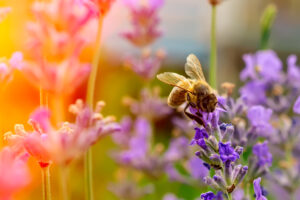Almost three-quarters of the major crop plants across the globe depend on some kind of pollinator activity, and over one-third of the worldwide crop production is affected by bees, birds, bats, and other pollinators such as beetles, moths and butterflies (1). The economic impact of pollinators is tremendous: Between $235–577 billion dollars of global annual food production relies on the activity of pollinators (2). Nearly 200,000 species of animals act as pollinators, including some 20,000 species of bees (1). Some of the relationships between pollinators and their target plants are highly specific, like that between fig plants and the wasps that pollinate them. Female fig wasps pollinate the flowers of fig plants while laying their eggs in the flower. The hatched wasp larvae feed on some, but not all, of the seeds produced by fertilization. Most of the 700 fig plants known are each pollinated by only one or a few specific wasp species (3). These complex relationships are one reason pollinator diversity is critical.
Measuring the Success of Conservation Legislation

We are now beginning to recognize how critical pollinator diversity is to our own survival, and many governments, from the local level to the national level are enacting policies and legislation to help protect endangered or threatened pollinator species. However, ecosystems and biodiversity are complex subjects that make measuring and attributing meaningful progress on conservation difficult. Not only are there multiple variables in every instance, but determining the baseline starting point before the legislation is difficult. However, there are dramatic examples of success in saving species through legislative and regulatory action. The recovery of the bald eagle and other raptor populations in the United States after banning the use of DDT is one such example (4).
Quite often conservation success must be monitored on a small scale in a local population, and researchers looking at genetic diversity may be working with species unique to their region that have not been well studied or that have physical or biochemical properties that make studying them difficult. Additionally, because the researchers are working with conserved species, they need to maximize the information that they learn from their limited samples. Obtaining high-quality nucleic acid in smaller scale experiments that can be used successfully for downstream genetic analysis requires reliable protocols and consistent reagent systems.
Do you have an unusual sample type that you are studying? Read about some of the unusual sample types our Technical Services Scientists have helped our customers work on.
Local Study to Monitor Biodiversity In Honeybees
In a study published in Nature Scientific Reports, Taurisano et al. sought to determine baseline genetic diversity of a protected honeybee species within the Emilia-Romagna region of Italy (6). The study investigates the distribution of mitochondrial DNA (mtDNA) haplotypes in honeybees. Using samples collected from 1,143 honeybees between 2020 and 2022, the researchers extracted DNA with the Wizard® Genomic DNA Purification Kit following the animal tissue protocol and used the DNA to provide a comprehensive genetic snapshot of the population’s haplotypes. They were able to obtain amplified fragments and sequences from the DNA extracted from each of the 1,143 bees collected.
Most of the bees (86.5%) carried the C1 mtDNA haplotype, characteristic of the A. m. ligustica subspecies, while 11% carried the C2 haplotype of A. m. carnica. Additionally, 1.3% and 1.1% of bees carried haplotypes from the A and M lineages, respectively, including two novel A haplotypes (A2w and A6a). The findings emphasize the importance of continued genetic monitoring to assess the impact of the law and suggest stricter policies to maintain the genetic integrity of the native A. m. ligustica subspecies.
Literature Cited
- Food and Agriculture Organization of the United Nations. Global Action on Pollination Services for Sustainable Agriculture. [Internet: https://www.fao.org/pollination/en Accessed: 13 September 2024]
- Bayer Global. The Value of Pollinators to the Ecosystem and Our Economy. [Internet: https://www.bayer.com/en/agriculture/article/economic-value-pollinators Accessed: 13 September 2024]
- Landry, C.L. (2010) Mighty Mutalisms: The Nature of Plant-pollinator Interactions. Nature Education Knowledge (3)10:37. [Internet: https://www.nature.com/scitable/knowledge/library/mighty-mutualisms-the-nature-of-plant-pollinator-13235427/ Accessed : 13 September 2024]
- U.S. Fish & Wildlife Service. Endangered Species. [Internet: www.fws.gov/program/endangered-species Accessed: 13 September 2024]
- Taurisano, V. et al. (2024) Distribution of honey bee mitochondrial DNA haplotypes in an Italian region where a legislative act is protecting Apis mellifera ligustica subspecies. Sci Rep 14 (20583) [Internet: https://doi.org/10.1038/s41598-024-71233-5 Accessed: 13 September 2024]
Michele Arduengo
Latest posts by Michele Arduengo (see all)
- An Unexpected Role for RNA Methylation in Mitosis Leads to New Understanding of Neurodevelopmental Disorders - March 27, 2025
- Unlocking the Secrets of ADP-Ribosylation with Arg-C Ultra Protease, a Key Enzyme for Studying Ester-Linked Protein Modifications - November 13, 2024
- Exploring the Respiratory Virus Landscape: Pre-Pandemic Data and Pandemic Preparedness - October 29, 2024
